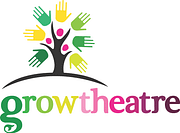
Name of School:
Year Group:
Aim of Work:
Length of Project:
What did we do?
This was a 2-year Action Research residency, with a different focus in each year.
Year 1: ‘How can drama and outdoor learning raise the confidence and communication levels of the most vulnerable children?’
Infants
With an ambition of closing the gap for all their learners, St Marie’s and Growtheatre undertook Enquiry-Based Research work and focused on some of the school’s youngest and most vulnerable children. Year One children were selected to participate in the work and the majority of those chosen either had English as an additional language or were previously looked after.
Although the whole school priority was to increase levels of achievement in writing, it was decided that this work needed to focus on foundation skills that affect academic attainment, therefore increasing communication and confidence levels were highlighted as the target areas.
In later terms, the project was linked directly to curriculum using drama to explore the history topic ‘Toys in the Past’. Following that, a Mantle of the Expert approach to learning was introduced and linked to science objectives focused on animals.
Year 2: ‘How can we embed creative, outdoor practice into the curriculum and ensure sustainability after this year?’
Juniors
Following the success of the previous year’s programme, the school were keen to embed the learning so they chose to use the majority of the funding on teacher and TA CPD to ensure sustainability of learning.
Rachel offered one-to-one bespoke CPD to the Woodland Team (made up of 5 teachers and 2 TAs). Additionally, 2 other teachers, a TA and their classes got involved in class-based CPD, all Key Stage 1 teachers and pupils worked with the Woodland Team and Rachel during an Outdoor Classroom Day and all members of school staff had CPD drama training.
Additionally, Rachel and the Woodland Team ran some parent and child sessions targeted at parents who the school felt could benefit from experiencing creative outdoor role-play and activities.
Finally, there was some money spent on equipment and resources, to facilitate creative outdoor learning.
What impact did the project have?
Year 1: impacts
The vast majority of the children selected for this Enquiry-Based Research did not achieve age expected outcomes at the end of Reception. This intervention was put in place to narrow the gap in the children’s academic achievements in Year 1, and worked to do so. For example 10/12 children involved successfully passed the Year 1 phonics screening, far exceeding the school’s target for this vulnerable group.
As the year progressed we successfully took the work into FS2 and KS2.
“I loved the session when I observed Rachel getting the children to be different toys and she was the toy maker. It gave me lots of ideas as a teacher but also enabled me to observe the children and understand their needs more, especially listening skills.” Y1 Teacher
The quality and results of Rachel’s work in year one meant that the head teacher at St Marie’s recommended Rachel’s work with vulnerable children from Year 1 to their colleagues at Sacred Heart Catholic Primary. As a result she was engaged to work with the ‘Hands On Group’ of Year 3 & Year 5 vulnerable children from Sacred Heart. They worked out of the classroom in a public space in the Rivelin Valley for 5 half days, with excellent results.
Year 2: impacts
Working outdoors became a whole school priority. Confidence in creative outdoor learning throughout the school increased through the year of CPD for staff. End of year school survey indicated:
-
- Greater confidence in delivering a lesson outdoors “I feel more confident!”
- A hugely increased number of lessons being taught outdoors.
- A removal of barriers to working outdoors – either partially or completely.
- An increase in teachers working outside creatively with their classes.
The removal of the practical barriers to working effectively outdoors was key to encouraging staff to take the risk of working in the woods. This was overcome by Saint Marie’s investing in resources by installing a shed, a seating area in the woods and the creation of story-focused resources.
For the school, the power of bringing in an artist to work with and alongside staff was felt very strongly: “having someone in school who is not a teacher and who can ask us challenging questions about our teaching is vital. Working with Rachel has offered us a different perspective and skill set – having someone who is NOT a teacher keeps learning and teaching fresh.”


